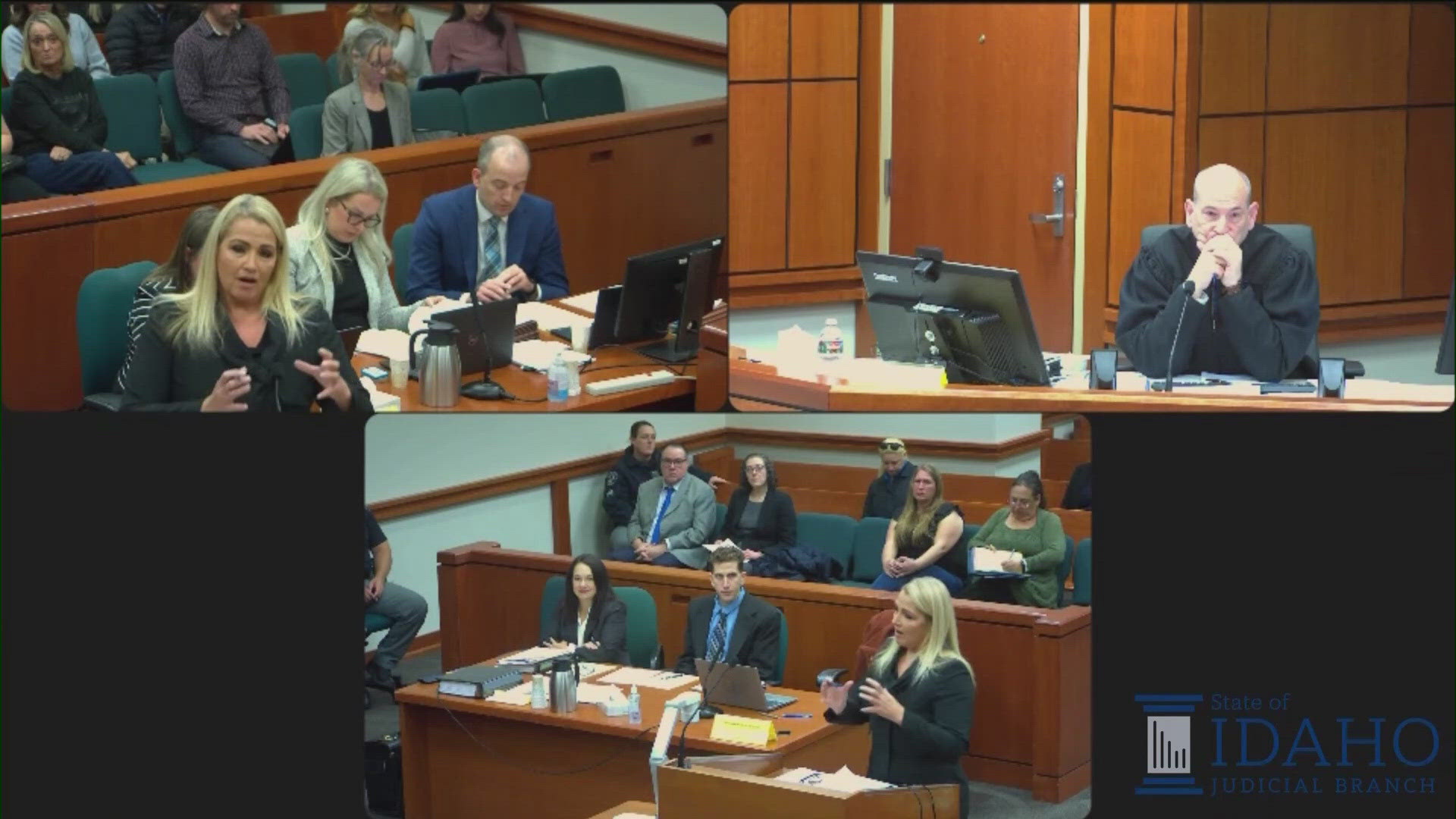KUNA, Idaho — In the span of less than a year, three Idaho inmates — two who had gender dysphoria and one who was living with sexual identification issues — killed themselves at the same facility housing a transgender inmate embroiled in a lawsuit with the state over gender confirmation surgery.
The suicides were mentioned in a September 2017 audit of the Idaho State Correctional Institution by the National Commission on Correctional Health Care, and they occurred between October 2016 and August 2017. Attorneys referenced that report during hearings in October in the case of Adree Edmo, a male-to-female transgender inmate who is suing the Idaho Department of Correction and Corizon Health, the department’s contractor, to obtain gender confirmation surgery.
On Aug. 23, the 9th Circuit Court of Appeals ruled Idaho officials must provide the surgery, something Gov. Brad Little on Friday vowed to appeal to the U.S. Supreme Court.
Edmo, 31, was sentenced to prison in April 2012 for sexually abusing a 15-year-old boy in Bannock County, according to court records. She will complete her sentence in April 2021. In June 2012, a prison psychiatrist diagnosed her with gender dysphoria, and a month later a prison psychologist made the same finding, according to an opinion handed down in December by U.S. District Judge B. Lynn Winmill.
Gender dysphoria is a mental condition in which the disconnect between a person’s birth gender and the gender with which they identify is severe, distressing, and harmful to a person’s quality of life. It’s a complex condition and may warrant a spectrum of treatments, from simply adopting a different name or appearance, to medical treatments such as hormone therapy and gender confirmation surgery.
Everyone involved in the case’s litigation, even Idaho’s expert witnesses and attorneys, agreed Edmo lives with gender dysphoria. The question was how to treat it.
CLINICAL PATHWAYS
Edmo’s case is a severe one, her attorneys argue. While in prison, she has tried to castrate herself twice. She was receiving hormone therapy, and wanted gender confirmation surgery. Her attorneys argued the state’s refusal of the surgery qualified as cruel and unusual punishment, because of the stress it caused her.
In particular, they argued, the distress from the dysphoria could cause her to self-harm. It was why attorneys felt it was relevant that of the three inmates who killed themselves at Idaho State Correctional Institution during that time, two had been diagnosed with gender dysphoria, and one had what attorneys referred to as “sexual identification issues” who was associated with the gender dysphoria inmate community.
The reference is contained in a transcript of the Oct. 12 hearing obtained by the Idaho Press Thursday.
It was at that same hearing that attorneys questioned Dr. Scott Eliason, Corizon’s regional psychiatric director who treated Edmo for a time. After an April 2016 assessment, Eliason did not authorize Edmo’s surgery.
Eliason on Oct. 12 testified there are about 30 inmates in Idaho Department of Correction custody who have been diagnosed with gender dysphoria. During the hearing, Winmill asked Eliason how many inmates the company cares for who have been diagnosed with gender dysphoria. He said he felt Idaho’s 30 inmates were representative of the population as a whole.
“So some of Corizon’s other states will be a lot bigger (in terms of population),” Eliason said.
When Winmill asked if that meant there were “probably hundreds, maybe even thousands” of inmates with gender dysphoria, Eliason responded by saying, “Yeah, very well could be.”
Winmill asked him if an inmate under Corizon’s care had ever received gender confirmation surgery, and Eliason said he didn’t believe any had.
“You know, I’m in a leadership role with Corizon as a regional psychiatric director, and I’m in meetings with this,” he Eliason said. “And they take this issue very seriously, and I have never once felt that Corizon was trying to guide us away from recommending surgery.”
Shaleen Shanbhag, one of Edmo’s attorneys, asked Eliason to testify about a two-page “Corizon guideline document” that had been sealed by the court. Dylan Eaton, Corizon’s attorney, said it might contain some of the company’s clinical pathways used in treating gender dysphoria. Winmill later confirmed the document listed treatment options.
“And this document does not mention gender confirmation surgery at all, correct?” Shanbhag asked.
Eliason read the document and confirmed it made no mention of gender confirmation surgery. Eaton, however, clarified with the doctor that the document only contained guidelines.
An email to Corizon was not immediately returned Friday. A company spokeswoman had not confirmed to the Idaho Press by Tuesday evening if the company lists sexual reassignment surgery as a clinical pathway for treatment of gender dysphoria.
12 CONTINUOUS MONTHS
Corizon could offer surgery if deemed necessary for gender dysphoria treatment, Eliason said at the Oct. 12 hearing.
“So it would include — I mean it’s not limited to this, but it would include psychotherapy, hormone treatment, surgical procedures,” he said.
He declined to recommend Edmo for surgery for two reasons, he said. One of them was because he did not feel Edmo had lived as a woman for 12 continuous months in a real-world situation, which is a generally accepted medical requirement for the procedure. He didn’t feel her time in prison qualified because it didn’t include the complexities she would encounter in life outside the prison walls.
Her attorneys argued she had lived for the requisite 12 months as a woman though — even in the face of discipline from Idaho Department of Correction staff.
Winmill clarified with Eliason one of the reasons he did not feel Edmo had satisfied the 12-months requirement was because Edmo was in prison.
“You’re disagreement is that it’s not 12 months in the real world,” Winmill said.
“That’s exactly it, yes,” Eliason said.
Eliason also declined to recommend surgery for Edmo because she had other mental illnesses he felt she needed to work through, namely depression, anxiety and substance abuse. He said he’d recommended group therapy for her, and she didn’t participate.
Shanbhag pointed out Eliason himself noted in medical records on multiple occasions Edmo “presented as feminine in demeanor and interaction style.” He noted she had groomed eyebrows; there are also records of her with painted nails and both ears pierced.
And, in fact, according to her attorneys, Idaho Department of Correction staff had disciplined her for it.
“And you were also aware that Ms. Edmo had been disciplined multiple times for looking too feminine, correct?” Shanbhag asked.
“I was aware that that’s what Ms. Edmo had told me,” Eliason said.
Lori Rifkin, another of Edmo’s attorneys, also referenced prison staff disciplining Edmo for appearing too feminine. It made up part of her closing arguments in the hearing.
Rifkin said Edmo maintained that identity “for six years, in the face of discipline — and this is important — defendants have disciplined her for, quote, ‘disobeying orders’ that were related to appearing feminine.”
“Some of that discipline involved escorting Ms. Edmo to the segregation unit and forcing her to spend time in segregation for this,” Rifkin said.
In an email to the Idaho Press, IDOC spokesman Jeff Ray said inmates “are not disciplined ‘for acting feminine or presenting in a feminine way.’ I do not know the history of the policy regarding this topic.”
Ray emailed the Idaho Press a copy of IDOC’s standard operating procedure regarding health care for inmates with gender dysphoria. According to the document: “Inmates diagnosed with gender dysphoria will be allowed to maintain their appearance in a way that is consistent with their identified gender. This means that inmates housed in a male facility, who identify as female and have been diagnosed with gender dysphoria, will be allowed to wear makeup and wear their hair in traditionally feminine hairstyles and present as female.”
The standard operating procedure was most recently updated on Oct. 5, 2018, a week before the hearing. Changes included “Reformatted, updated terminology; provided clarification regarding inmates with gender dysphoria including how they are to be addressed, appearance, commissary, and various other issues.”
This article originally appeared in the Idaho Press, read more on IdahoPress.com.
More from our partner Idaho Press: Get your bib on! Bands Brews & BBQ coming your way



